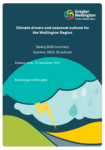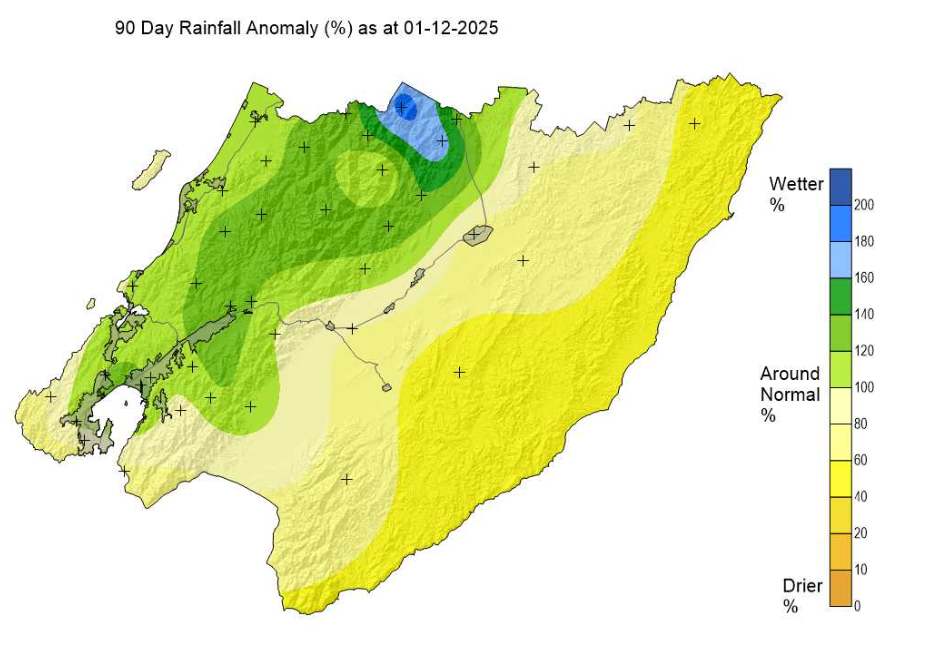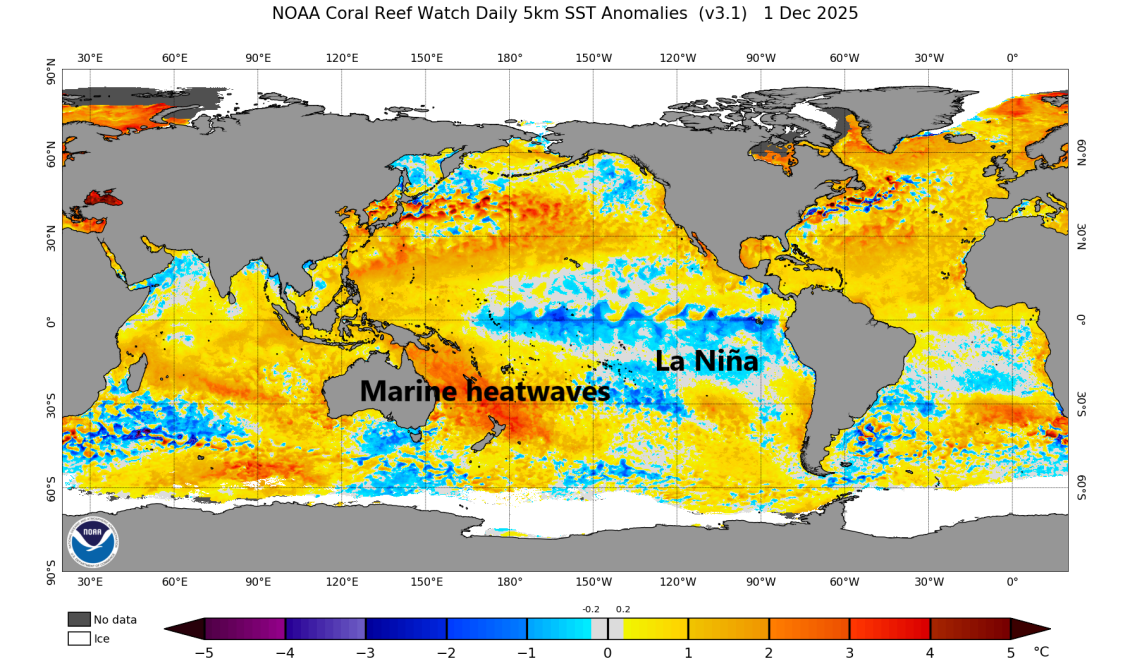A brief summary of climate and hydrological conditions in the region.
This service is regularly updated during periods in which closer monitoring is required (regardless of time of the year), in recognition that there is potential for dry spells, or irregular hydrological recharging. It does not define an official council position on drought or drought declaration. Outside of dry periods, less frequent updates synchronise with our latest seasonal outlooks.
Updated 1 December 2025
Next update due when there is a significant change of conditions or a new seasonal outlook.
Background
Spring was dominated by strong westerly flows with below average rainfall east of the ranges, due to the shadow or Foehn effect. Temperatures have been nearly two degrees above the long-term average with marine heatwaves gradually developing around the North Island, especially into December as La Niña continues to evolve. As a rule of thumb, it rained about half the long-term average in the eastern Wairarapa and about one and a half the long-term average over the high catchments in the Tararua ranges. This sharp contrast meant that a sustained water flow kept running downstream into the lower catchment areas for the most part, helping ameliorate the overall building dryness.
Spring rainfall anomalies (left image above) show above average rainfall over the high catchments, and below average east of the ranges. A fierce westerly flow dominated most of spring, with a more mixed La Niña flow starting to manifest from mid-October onwards. Temperatures have been nearly two degrees above average and marine heatwaves are now developing, as the effects of La Niña continue to manifest (right image above).
Current situation
Soil moisture levels were sitting at the below average mark for most of the Wairarapa at the beginning of summer, albeit slightly less dry compared to this time last year. Most of the high elevation areas within the catchments over the Tararua ranges received plentiful replenishment over spring, helping maintain the minimum flows required for water take despite the high evapotranspiration associated with warmer than normal temperatures. The national drought index is currently classifying the eastern Wairarapa as dry, and the rest of the region as normal.
Meteorological outlook
International climate models are predicting that a La Niña flow will continue to mature throughout summer, albeit in a mixed way with westerlies still possible. A more pronounced shift to easterlies over summer should be beneficial to the eastern Wairarapa, helping prevent an aggravation of the growing dryness. With temperatures significantly warmer than average, pressure will continue to mount towards low flows and dry soils initially, even though the risk of a major meteorological drought this summer remains low for now, as La Niña and marine heatwaves increase the chances of heavy rainfall and thunderstorms later in the season.
Climate change
The ‘normal’ longer-term water balance is becoming increasingly hard to maintain quite possibly due to climate change influences, and increased high frequency climate variability, with more unreliable weather patterns. Droughts are expected to become more severe and frequent in the Wellington region, particularly in the Wairarapa. Even if international climate policy efforts were to successfully contain global warming under 1.5-2 degrees (the Paris Agreement’s ambition), it is important that we enhance our water resilience and be prepared for more unreliable climate patterns with both extreme dry and extreme wet periods. We note that the warming of the land also means that evapotranspiration will greatly increase, so the soil will likely need more ongoing rain to maintain ideal moisture levels, compared to what it has needed in the past.
View the latest national drought index state
View the national drought forecasting dashboard
View the latest seasonal report:
Climate drivers and seasonal outlook for the Wellington Region - Spring 2025 summary Summer 2025-26 outlook


date_range Published 18 Dec 2025
Download now (PDF 1.7 MB) get_appBrowse the data
Anomaly Maps
How different has recent rainfall/soil moisture been compared with the same time in previous years?
Site-specific graphs
| Area | Rainfall | Soil Moisture |
| Kapiti Coast (lowland) | Otaki at Depot | |
| Kapiti Coast (high altitude) | Penn Creek at McIntosh | |
| Porirua | Horokiri Stream at Battle Hill | |
| Wellington City | Kaiwharawhara Stream at Karori Reservoir | |
| Hutt Valley (upper catchment) | Hutt River at Kaitoke Headworks | |
| Upper Hutt | Upper Hutt at Savage Park | Upper Hutt at Savage Park AQ |
| Wainuiomata | Wanuiomata River at Wainui Reservoir | |
| Wairarapa (high altitude) | Waingawa River at Angle Knob | |
| Wairarapa Valley (north) | Kopuaranga River at Mauriceville | |
| Wairarapa Valley (Masterton) | Ruamahanga River at Wairarapa College | Wairarapa College AQ |
| Wairarapa Valley (south) | Tauherenikau River at Racecourse | Tauherenikau River at Racecourse |
| Wairarapa (north-eastern hills) | Whareama River at Tanawa Hut | Whareama River at Tanawa Hut |
| Wairarapa (south-eastern hills) | Waikoukou at Longbush | Waikoukou at Longbush |
Get in touch
- Phone:
- 0800496734
- Email:
- info@gw.govt.nz


